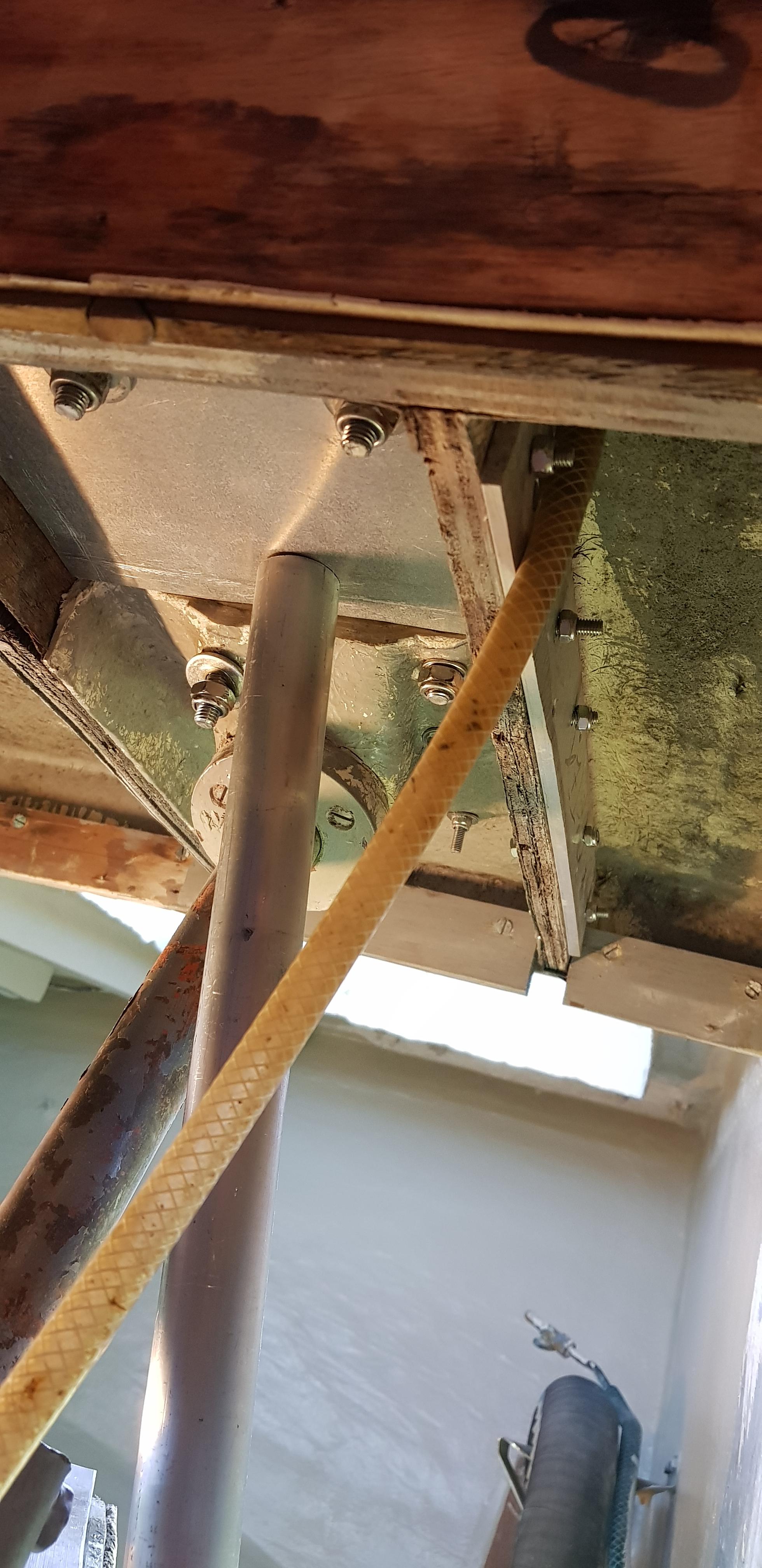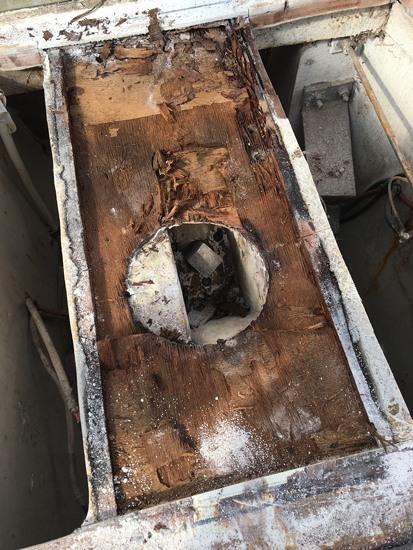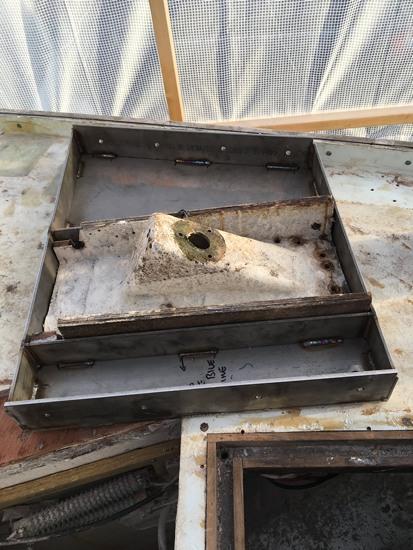Welcome Back › Forums › Deck and Hull › Deck and deck fittings › Sagging aft deck under mizzen mast step
- This topic has 6 replies, 4 voices, and was last updated 3 years, 5 months ago by
Ollie Holden.
-
AuthorPosts
-
May 20, 2019 at 09:25 #26582
 Arild JaegerParticipant
Arild JaegerParticipantFor some years I have watched the deck sagging under the pressure from the mizzen mast. A gap had formed between the emergency tiller deck fitting and the deck itself and water had been coming in.
This spring I removed the mizzen mast step and the emergency tiller deck fitting. I suspected that the wooden spacing material in the sandwich deck would be in a very bad state. Having cut away a part of the delaminated lower GRP, I found that the plywood was still in good shape. To lift the deck, I installed a support from the hull to an aluminium plate below the plywood under the mizzen mast step. I also replaced the screws holding the emergency steering deck fitting with bolts having nuts below the lower GRP sandwich layer. Now the aluminium plate pushes the deck back up and the bolts tightens the deck sandwich.
One of the vertical sandwich beams under the deck next to the mizzen step was broken, so I reinforced it by bolting on a piece of aluminium.

 June 17, 2019 at 04:41 #26607
June 17, 2019 at 04:41 #26607 VanParticipant
VanParticipantThanks Arild, this is interesting. Nice idea to put in that support strut.
I had no idea that the deck was so dependent upon the small (it seems) plywood beam. Almost makes me think I should add aluminum supports like you did, but before it breaks.
There are a surprising number of shrouds for this mast, and the downward pressure is of course cumulative.
I set the 5/32″ shrouds to 300# and the 7/32 to 500# (about 10% of breaking strain is my rule). And the running backstays get set to something tight but I never measure it because it always seems to be changing. The weight of the mast is around 250 lbs. So that means there is something like 4 x 300 + 2 x 500 + 250 = 2450 pounds of force excluding the backstays and ignoring the trigonometry of the angles, and what happens when sailing. That’s a lot, never thought of it like that before.
Van
June 19, 2019 at 14:12 #26608 Chihili QParticipant
Chihili QParticipantLovely job Arild, I’ve been out of the loop for some time but have now retired and hope for a bit more time get my head round things! Last year Chihili Q was in Pwllheli until June for re-rigging and a bit of a refurbishment which included a fix to the sagging aft deck. The mahogany ply pad was rotten so this was replaced by glass and epoxy resin, along with replacement of the somewhat soggy transverse bulkhead supporting the deck, attention to the teak deck and stern locker, and a thick Iroko wood pad to spread the load between my gas lockers more evenly. I took her to Scotland and met a delightful couple in the new Oban marina who had just acquired a lovely, blue Nicholson 38; sadly as usual their names have disappeared from my contact list but I might have a record in my logbook. Anyway the skipper pointed out that in the original design of the Nic 38 the main mast’s backstay was originally attached to the mizzen mast giving it considerable support as he demonstrated on his boat! Chihili Q’s backstay is split and anchored to each side of the afterdeck, obscured in the photo by the training ship behind her. Best wishes, Adrian.
June 21, 2019 at 11:34 #26610 Chihili QParticipant
Chihili QParticipantIn fact, on reflection, I forgot that I had previously had the after deck sag corrected by a different boat-yard in Pwllheli, who put in a woefully inadequate glassfibre support with ribs running longlitudinally to add strength, whereas if anything these should have been transverse. Nothing like doing it yourself, which applies to any piece of work, on the boat or at home in my experience if you can be on site with appropriate tools etc! Except maybe I’m getting too scatter brained to do so anymore.
September 26, 2019 at 11:36 #26639 Arild JaegerParticipant
Arild JaegerParticipantThank you for your encouraging comments.
The weight of the mizzen mast is not to bad in itself. I can easily carry it alone. The pressure on the deck is mainly from the four shrouds/stays.
Far Out has the original configuration where the aft mainstay is held by the mizzen mast step (and led up along the mizzen mast to clear the aft cabin roof) as mentioned by Adrian. This helps to reduce the downward force – at least at the front end of the mizzen mast step .
Arild
July 18, 2022 at 01:49 #26660Ollie Holden
ParticipantHere was my solution – a big job undertaken as part of replacing the teak deck. We found that the ply under the mast was rotten, so built a stainless steel frame to fit between the two longitudinal bulkheads. This was bolted between the bulkheads and then glassed over to form the camber on the deck. We re-attached the original upper fibreglass moulding for the upper end of the rudder shaft to the stainless frame. It could survive a direct hit from a ballistic missile now I think.



-
AuthorPosts
- You must be logged in to reply to this topic.